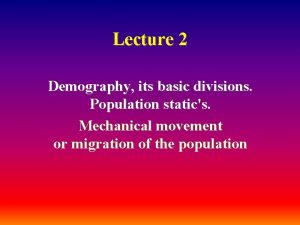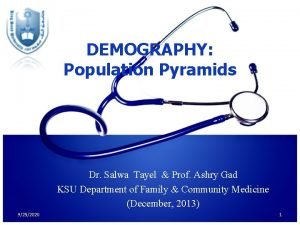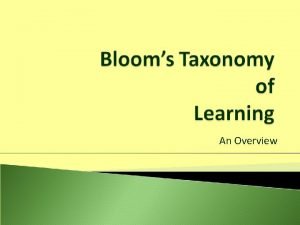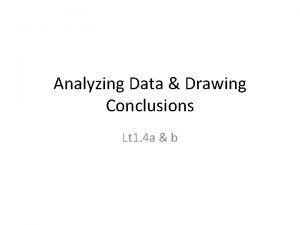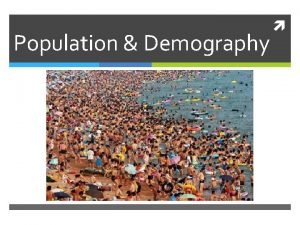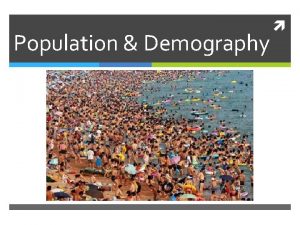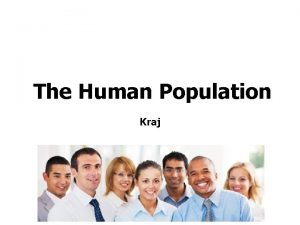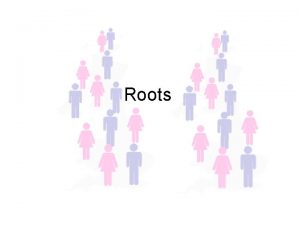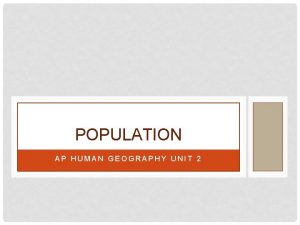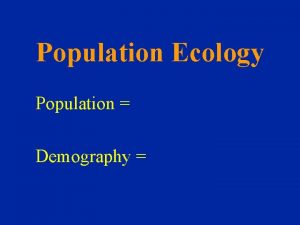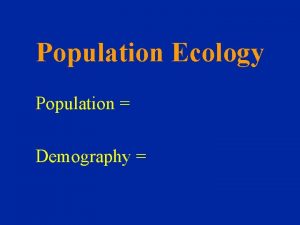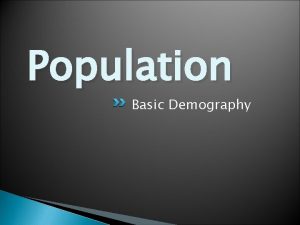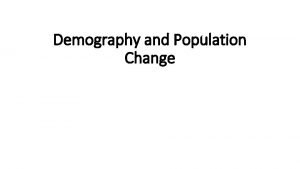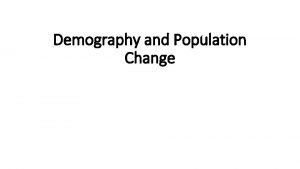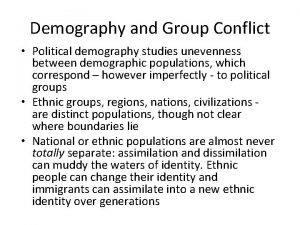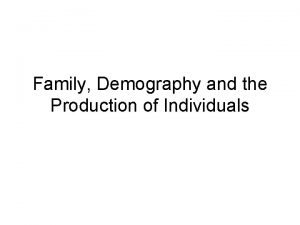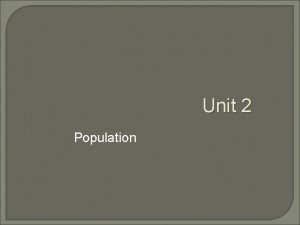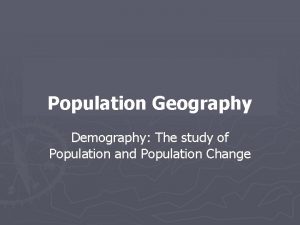Population Learning Goals understand demography understand analyze and

































- Slides: 33

Population

Learning Goals understand demography - understand, analyze and calculate population growth rate - understand what population density means and how to calculate it. -

Populations Demography is the study of Human Populations Why is it important to study? the world’s population reached 7 billion in the fall of 2011 Click here.

Why is it important to study?

Why is it important to study? Because large populations impact a society; - Sustainability Urbanization Health care Education Economy Environment

Where are the largest countries? Where are the largest populations in the world? Cartogram – is a thematic map showing statistical data (in our case demographic data).

What are the trends? Correlation – when two variables show a relationship between them. ex. There is a correlation between speed you drive and traffic accidents. Are there any correlations between size of country and size of population?

What are the trends? Important Question Are there correlations between population size and social issues?

Population Density

► Population density is a way of describing how crowded a place is. Population density = number of people living in an area size of area (in km 2) ► Complete the following table for these places using a calculator:

Place Population Very rural 50 Megacity 17, 500, 000 Suburbia 160, 000 Rural Area (km 2) 1, 000 0. 05 1, 500 11, 667 175 4, 500 Population Density (people/km 2) 914 650 7


1. Write these questions in your book. a) Is Canada’s population evenly spread out across the country? Why or why not? b) What is the population density for most of Canada? (low, medium, high) c) Do you think Canada is a crowded country? Explain.

Answer the questions using the following map.

By The Numbers…

An example… ► Let’s say a country has a population of 30, 000. § Births = 390, 000 § Deaths = 210, 000 immigrants = 220, 000 emigrants = 60, 000 ► How can we figure out how fast their population is growing? ? ?

► Birth Rate – the number of people born per year x 1000 population For example: BR = 390, 000 x 1000 30, 000 BR = 13 (this country had 13 people born per 1, 000 people in that country)

► Death Rate – the number of deaths per year x 1000 population For example: BR = 210, 000 x 1000 30, 000 DR = 7 (this country had 7 people die per 1, 000 people in that country)

► Natural Increase Rate = birth rate – death rate Example: 13 – 7 = 6 (per 1000) This means that the natural increase rate for this country is 6 people per 1000

► Immigration Rate the number of immigrants per year x 1000 population For example: IR = 220, 000 x 1000 30, 000 IR = 7 (this country had 7 people immigrate per 1, 000 people in that country)

► Emigration Rate the number of emigrants per year x 1000 population For example: ER = 60, 000 x 1000 30, 000 ER = 2 (this country had 2 people emigrate per 1, 000 people in that country)

► Net Migration Rate = Immigration Rate – Emigration Rate Example: 7 – 2 = 5 (per 1000) This means that the net migration rate for this country is 5 people per 1000

► Population Growth Rate = Natural Increase Rate + Net Migration Rate Example: 6 + 5 = 11 (per 1000) This country is growing at a rate of 11 people per 1000.

► Always express the population growth rate as a percent!! 11 X 100 = 1. 1 % 1000 Or you can simply move the decimal one spot to the left.

►The Rule of 70 (Doubling Time) 70 Population Growth Rate (as a percent) 70 = 63. 6 years 1. 1 What this tells us is that the population of that country will double in 63. 6 years.

►Example – The African country of Togo has a population growth rate of 3. 6% 70 = 19. 4 years 3. 6 The population of Togo will double in under 20 years.

Time to practice…. ► A country has a population of 1, 807, 242. § Births = 50, 250 § Deaths = 42, 658 immigrants = 13, 605 emigrants = 11, 500 ► Do all the calculations (just like in the example we did)

Answers ► Birth rate = 27. 8 per 1, 000 ► Death rate = 23. 6 per 1, 000 ► Natural increase rate = 4. 2 per 1, 000 ► Immigration rate = 7. 5 per 1, 000 ► Emigration rate = 6. 4 per 1, 000 ► Net Migration rate = 1. 1 ► Population Growth rate (%) = 5. 3 ► Doubling Time = 132. 1 years = 0. 53%

Another practice question…. ► A country has a population of 726, 000 § Births = 12, 500 § Deaths = 6, 100 immigrants = 3, 605 emigrants = 1, 500 ► Do all the calculations (just like in the example we did)

Answers ► Birth rate = 17. 2 per 1, 000 ► Death rate = 8. 4 per 1, 000 ► Natural increase rate = 8. 8 per 1, 000 ► Immigration rate = 5 per 1, 000 ► Emigration rate = 2. 1 per 1, 000 ► Net Migration rate = 2. 9 ► Population Growth rate (%) = 11. 7 ► Doubling Time = 60 years = 1. 17%

Homework question…. ► A country has a population of 8, 000 § Births = 200, 000 § Deaths = 40, 000 ► Do all the calculations. immigrants = 125, 000 emigrants = 30, 000

Homework Answers ► Birth rate = 25 per 1, 000 ► Death rate = 7. 3 per 1, 000 ► Natural increase rate = 17. 7 per 1, 000 ► Immigration rate = 1. 25 per 1, 000 ► Emigration rate = 1. 5 per 1, 000 ► Net Migration rate = 0. 25 ► Population Growth rate (%) = 17. 0 ► Doubling Time = 41 years = 1. 7%

The end….
 Demographic data definition
Demographic data definition Strategic goals tactical goals operational goals
Strategic goals tactical goals operational goals Strategic goals tactical goals operational goals
Strategic goals tactical goals operational goals Static demography
Static demography Cso business demography
Cso business demography Elements of demography
Elements of demography Hotelling model ap human geography
Hotelling model ap human geography Difference between a sample and a population
Difference between a sample and a population Components of demography
Components of demography Slash and burn agriculture antonym
Slash and burn agriculture antonym Cognitive objectives examples
Cognitive objectives examples Understand apply analyze evaluate create
Understand apply analyze evaluate create 認知領域
認知領域 To understand recursion you must understand recursion
To understand recursion you must understand recursion General goals and specific goals
General goals and specific goals Motivation in consumer behaviour
Motivation in consumer behaviour Population ecology section 1 population dynamics answer key
Population ecology section 1 population dynamics answer key Section 1 population dynamics answer key
Section 1 population dynamics answer key Population ecology section 1 population dynamics
Population ecology section 1 population dynamics Chapter 4 section 1 population dynamics study guide
Chapter 4 section 1 population dynamics study guide Cuadro comparativo de e-learning
Cuadro comparativo de e-learning Example of learning objectives
Example of learning objectives Big picture learning goals
Big picture learning goals Amt learning goals
Amt learning goals A repetition of or return to criminal behavior *
A repetition of or return to criminal behavior * Establish mathematics goals to focus learning
Establish mathematics goals to focus learning Knowledge harvest ipc
Knowledge harvest ipc Advantage and disadvantage of observation method
Advantage and disadvantage of observation method Venn diagram of media and information literacy
Venn diagram of media and information literacy Examine the picture carefully and answer the question
Examine the picture carefully and answer the question What is media information
What is media information Programs that organize analyze and graph numerical data
Programs that organize analyze and graph numerical data Analyzing and drawing conclusions
Analyzing and drawing conclusions Ritual or expressive model of communication
Ritual or expressive model of communication



